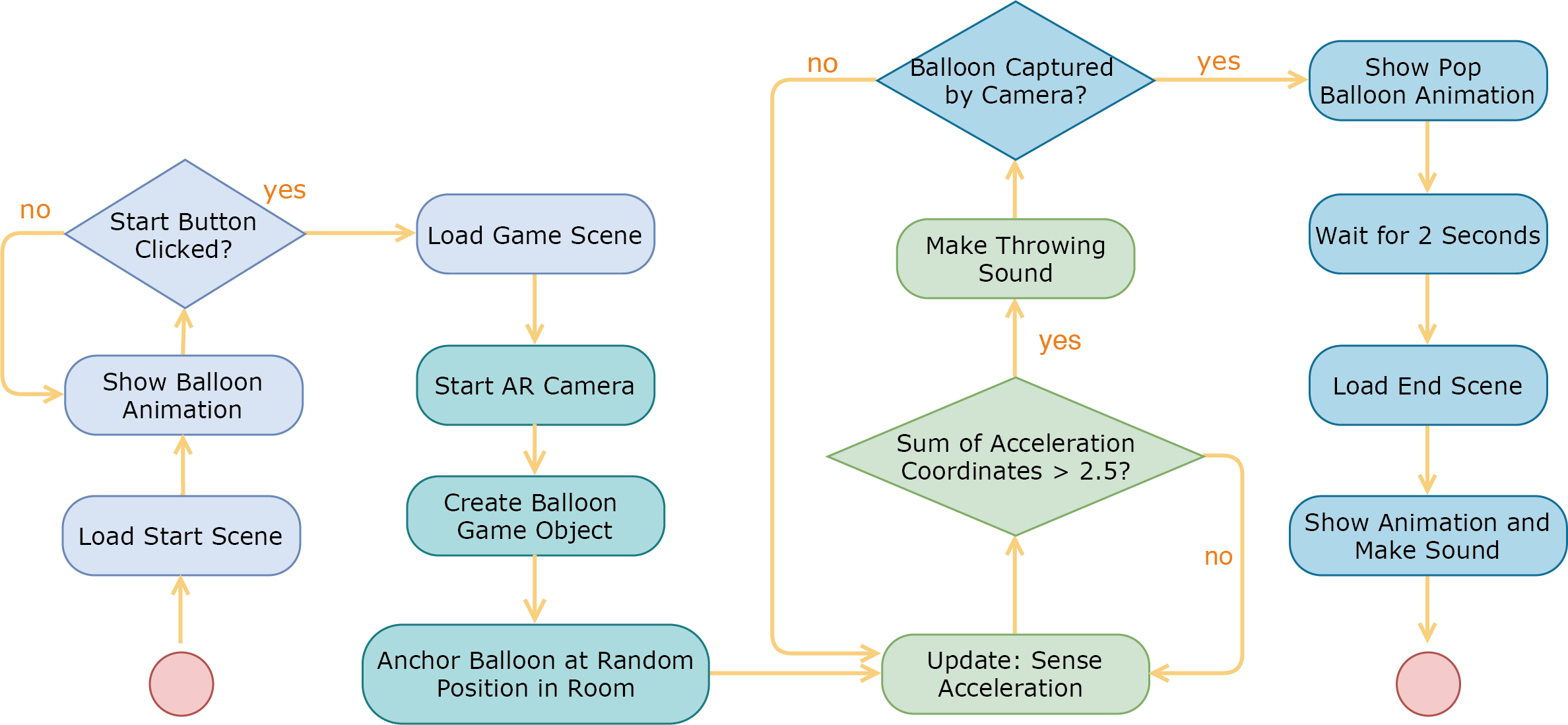How to design an AR game to motivate players to do
physical activities during pandemic?
Keywords:
Pervasive computing, AR game, Unity, Prototying
Role:
Game flow designer, Developer for smart sensing
Year:
2021, 10 weeks
Team members:
Amy de Lange, Claudia Libbi, Daphne Theodorakopoulos,
Yi Zhang
Professors:
Andreas Kamilaris, Jeroen Klein Brinke
2021, 10 weeks
Team members:
Amy de Lange, Claudia Libbi, Daphne Theodorakopoulos,
Yi Zhang
Professors:
Andreas Kamilaris, Jeroen Klein Brinke
About:
Under the context of social distancing due to global pandemic, we created a two-player AR game by incorporating physical location and input by physical activity. The goal is to motivate users to do physical movements. The “escape room” element enables users to collect memories together by working towards mutual goals, and to reduce loneliness and isolation during self-distancing. This game can add a fun break to daily life and interrupt routines.
![]()
Under the context of social distancing due to global pandemic, we created a two-player AR game by incorporating physical location and input by physical activity. The goal is to motivate users to do physical movements. The “escape room” element enables users to collect memories together by working towards mutual goals, and to reduce loneliness and isolation during self-distancing. This game can add a fun break to daily life and interrupt routines.
See Demo︎︎︎

![]()
Target group
Target group
- People in isolation and studying/working from home
![]()
Goal
Goal
- Intuive and attractive to children and young adults
- Help players to be physically and mentally active
- Reduces feelings of social isolation
and loneliness
- As a fun break to daily life and interrupt routines
︎
Software Choices
Software Choices

- Convenient and multi-platform compatible environment for AR smartphone applications

- Interactive AR: accuracy of localisation indoors and with hand-held smartphone
camera
- Feasible for processing power,
integrating smart sensor on smartphone
- Easy set-up
︎
Technology Support
︎
Design Choices
Design Choices

︎
Game flow
To tackle the physical aspect, the game uses movement recognition where the players need to move their smartphones in a specific direction, speed and location. The prototype takes advantage of the accelerometer to sense the desired user movement.
Prototype game flow︎︎︎

︎Game flow introduction
︎Keypoints not in the flow
- Sensing hitting motion through accelerometer: threshold
determined by taking measurements while performing the
motion with an Android phone.
-
“Spear-throwing” sound for correct movement:
-
“Popping” sound for hitting correct location:
- Congratulations screen when balloon pops after successful hit
- Balloon “burst” is triggeredwhen the movement reach set minimum of acceleration
- Hand holding dart on screen to help aiming at the balloon
& hints
︎Keypoints not in the flow
-
In a multiplayer configuration: both players find AR objects
in the same relative position
- Level up: collaborative work to find and hit the ballons
- Rely on only sharing relative positioning information
- Avoid sharing 1) sensitive visual data and 2) global positioning that would disclose player locations
Demo video ︎︎︎
︎
Future improvement
Future improvement
Our prototype implementation focusses on sensing and output. It is a single-player, offline game, so no privacy issues arise from sharing
sensitive data.
To make the game more pervasive and interesting and to maximise health benefits, future modifications are proposed.
︎Game design
- Communication: enrich players’ interaction using Unity’s Networking API; players are provided different information and need to collaboratively solve problems
- Output: add more sound effects, sonification, haptics
- Add game elements and challenges to make it into an escape room
(e.g. objects to avoid)
- Other hardware: context-controlled, more pervasive
(e.g. head-mounted display)
- Other purpose: training special forces (e.g. firemen) in situations of terrorism, disaster, etc., to get familiar with unknown places
︎Date privacy
Our game design does not require any visual data to be shared, only a relative position, the game state and audio data [data minimisation]. The data analysis would process user data. To ensure privacy, the user needs to consent for it and personal data will be anonymized [Lawfulness/fairness/transparency, Integrity and confidentiality]. Game data irrelevant for the analysis will not be stored (e.g. audio) [data minimisation, storage limitation, purpose limitation].
References
[1] Zhang, X., Yao, X., Zhu, Y., & Hu, F. (2019). An ARCore based user centric assistive navigation system for visually impaired people. Applied Sciences, 9(5), 989.
